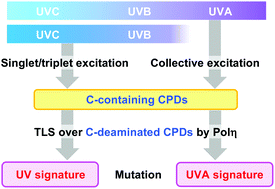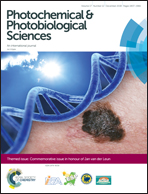Mechanistic considerations on the wavelength-dependent variations of UVR genotoxicity and mutagenesis in skin: the discrimination of UVA-signature from UV-signature mutation
Abstract
Ultraviolet radiation (UVR) predominantly induces UV-signature mutations, C → T and CC → TT base substitutions at dipyrimidine sites, in the cellular and skin genome. I observed in our in vivo mutation studies of mouse skin that these UVR-specific mutations show a wavelength-dependent variation in their sequence-context preference. The C → T mutation occurs most frequently in the 5′-TCG-3′ sequence regardless of the UVR wavelength, but is recovered more preferentially there as the wavelength increases, resulting in prominent occurrences exclusively in the TCG sequence in the UVA wavelength range, which I will designate as a “UVA signature” in this review. The preference of the UVB-induced C → T mutation for the sequence contexts shows a mixed pattern of UVC- and UVA-induced mutations, and a similar pattern is also observed for natural sunlight, in which UVB is the most genotoxic component. In addition, the CC → TT mutation hardly occurs at UVA1 wavelengths, although it is detected rarely but constantly in the UVC and UVB ranges. This wavelength-dependent variation in the sequence-context preference of the UVR-specific mutations could be explained by two different photochemical mechanisms of cyclobutane pyrimidine dimer (CPD) formation. The UV-signature mutations observed in the UVC and UVB ranges are known to be caused mainly by CPDs produced through the conventional singlet/triplet excitation of pyrimidine bases after the direct absorption of the UVC/UVB photon energy in those bases. On the other hand, a novel photochemical mechanism through the direct absorption of the UVR energy to double-stranded DNA, which is called “collective excitation”, has been proposed for the UVA-induced CPD formation. The UVA photons directly absorbed by DNA produce CPDs with a sequence context preference different from that observed for CPDs caused by the UVC/UVB-mediated singlet/triplet excitation, causing CPD formation preferentially at thymine-containing dipyrimidine sites and probably also preferably at methyl CpG-associated dipyrimidine sites, which include the TCG sequence. In this review, I present a mechanistic consideration on the wavelength-dependent variation of the sequence context preference of the UVR-specific mutations and rationalize the proposition of the UVA-signature mutation, in addition to the UV-signature mutation.

- This article is part of the themed collections: Commemorative issue in honour of Jan van der Leun and 2018 Perspective article collection


 Please wait while we load your content...
Please wait while we load your content...